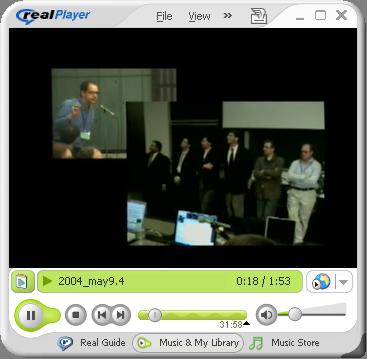 David Ascher reports on the Toronto KMDI Open Source Conference:
David Ascher reports on the Toronto KMDI Open Source Conference:
 David Ascher reports on the Toronto KMDI Open Source Conference:
David Ascher reports on the Toronto KMDI Open Source Conference:
Last May, I had the pleasure of participating in yet another conference on open source. Some of the topics covered were the "same old, same old", but there was one set of exchanges that really struck me as unique -- the debate between Eben Moglen, counsel for the FSF, and David McGowan, a self-described "capitalist tool". The video archives are available (although uptime seems spotty), and I encourage people interested in legal issues surrounding the GPL in particular to listen in. Of particular interest:David, you can link into those video archives. But it's insanely (and unnecessarily) hard to do it. In this case, since Real streams are available, here's how:(Oh, how I wish I could address into parts of the debate with better instructions than "see Question 7 in the afternoon Q&A". Yes, Jon, you're right.) [David Ascher]
- Eben Moglen's speech (Day 1, Morning Session, Part 2)
- David McGowan's counter-speech (Day 1, Afternoon Session, Part 1)
- The discussion period between the two of them (Day 1, Afternoon Session, end of Part 2)
Start with the link to the archives.
Choose the Real stream for Day 1, afternoon session, Part 2
Right-click the embedded Real player and select Play in Real Player.
Right-click, View Clip Source to reveal the name of the stream file: RMmediaPtr.rpm (which resolves to http://epresence.tv/archives/2004_may9_4/RMmediaPtr.rpm
Retrieve its contents (e.g., curl http://epresence.tv/archives/2004_may9_4/RMmediaPtr.rpm). Finally, we have the URL of the stream: rtsp://kmdi.utoronto.ca:555/osconf/2004_may9.4.rm
Load that URL into RealPlayer, and find a segment of interest. Here's one: David Ascher, asking a question about open source PVRs. The question begins: "As somebody who is knowledgeable about software, but a fairly frustrated consumer of media..."
Note the start/stop times: 1:14:45 and 1:16:38
Here is the URL for the segment: rtsp://kmdi.utoronto.ca:555/osconf/2004_may9.4.rm?start=1:14:45&end=1:16:38
However, browsers tend not to react well to raw rtsp: URLs, so they are typically delivered in a .RAM wrapper file. A Real server usually provides a "ramgen" pseudo-directory that will do that for you. Thus: http://kmdi.utoronto.ca:555/ramgen/osconf/2004_may9.4.rm?start=1:14:45&end=1:16:38
Here, finally, is the link to David's part of the Q and A.
If we want media content to flow naturally on the web, the first and most obvious thing to do is publish the stream URLs. The second thing is to put some simple authoring capability into the player. It needs two new buttons: Start Clip and End Clip. When you click Start Clip, it notes the start time of a clip. When you click End Clip, it notes the end time and gives you the URL of the clip.
It's no wonder that David is a "frustrated consumer of media." We deploy AV content on the web in a style that emulates television but is antithetical to the web. I'd like to change that.
Update: David responds, noting that the media URLs are, indeed, published. Cool! That means that some of the painful procedure I outlined, which is so often necessary, isn't needed in this case. David also notes that, in addition to making AV content on the web less TV-like, we need to make TV more web-friendly. Absolutely right. We ought to be able to annotate and filter TV in a collaborative way, just as we already do easily with textual web content, and can do painfully with web AV content. Because the mechanisms of annotation and filtering enable detailed measurement of what we attend to, business models will certainly emerge that can sustain all these forms of collaborative filtering. What exactly those models will be is, of course, a question of intense interest to many people.
Former URL: http://weblog.infoworld.com/udell/2004/08/18.html#a1062